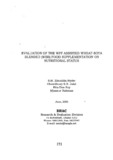Evaluation of the WFP assisted wheat-soya blended (WSB) food supplementation on nutrional status
Citation
Hyder, S. M. Z., Jalal, C. S. B., Roy, R. D., & Rahman, M. (2000, June). Evaluation of the WFP assisted wheat-soya blended (WSB) food supplementation on nutrional status. Research Reports (2000): Health Studies, Vol - XXIX, 171–194.Abstract
Wheat soya blended (WSB) food was distributed ~ong 74,000 'poorest of the poor'
households in 5 highly flood-affected districts in Bangladesh under an agreement signed
in May 1999 between BRAC and World Food Programme. Each selected household
received 10 kg WSB per month, and only under-5 children and pregnant/lactating
mothers were entitled to consume the food for a period of five months.
The objective of the study was to evaluate the impact of WSB supplementation
programme with special emphasis on nutritional status of under-5 children. Other aspects
· of the programme such as efficacy of targeting, quality of the WSB food distributed,
acceptability and consumption of WSB food were also evaluated.
The study followed a pre-post design with a comparison group. Karnarkhond thana (subdistrict)
in Sirajganj district was selected as the intervention area (n=760 under-5
children), while Dhunot thana in Bogra district was selected as the comparison area
(n=764 under-5 children). Data were collected at baseline and after 5 months intervention
in both the areas. In addition, monthly data were also collected on some selected
indicators. The Salter scale was used to collect weight data to nearest 1 00 g and TALC
MUAC tape was used to collect mid-upper-arm circumference (MUAC) to nearest 1 mm.
Age of children was recalled by mothers with the help of a local calendar of events
specifically developed for this study. Gomez classification was used to define severity of
malnutrition and underweight was defined according to criterion set by WHO (weightfor-
age <80% NCHS median). Severe malnutrition was defined as MUAC <125 mm.
The results indicate that selection of the households according to the set socio-economic
criteria was quite accurate. All the selected households belonged to the poorest of the
poor as indicated by household landholding, occupation of household head, sanitation and
literacy. As high as 98% of the selected households did not have BRAC RDP
membership. The quality of WSB food at the point of distribution was not acceptable
since 85% of the children received the food infested with insects during first month.
Although the situation improved over time, 64% of the children received WSB food
either infested (11 %) or damp/clustered (53%) during the last round of the distribution.
Most women (88%) could prepare the WSB as per instruction given prior to distribution
by BRAC staff. On average, 1.5 children shared WSB food per households.
Consumption of WSB food by pregnant/lactating mothers was at minimum level. About
98% of the children liked the taste of WSB food. Median consumption of WSB in 24
hours was 300 g per child during the first month, which went down to 200 g during
second and third month, and finally to 100 g during the last month. The reason for such
downward trend of WSB food consumption was probably sharing of the food by other
'family members, which often-- remained unreported. The 5-month WSB food
supplementation showed a significant impact on reducing the prevalence of malnutrition.
The intervention was also found effective in treating underweight as well as severe
malnutrition. The reduction of the prevalence of underweight was 9% in supplemented
children compared to 6% in non-supplemented children (p=O.OO). In regression analysis,
the intervention showed significant effect on increasing mean MUAC (p=O.OO) and mean
weight-for-age {p=0.03) after controlling for important confounding factors, such as sex
and age of the children, total duration of diarrhoea in days during the five months
supplementation period and nutritional status at baseline. A subset of children was
analysed to study the effectiveness of the intervention in treating underweight and severe
malnutrition. Children who were found underweight and severely malnourished at
baseline were included. A significantly higher reduction of the prevalence of
underweight was observed among children in the intervention area compared to the nonintervention
area (68% vs. 76%; p=0.007). Similarly, the prevalenc~ of severe
malnutrition reduced to 28% from the baseline figure of 100% in the intervention area
compared to its reduction to 43% in the non-intervention area (p=0.02).

